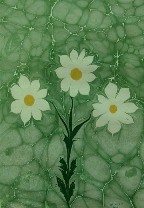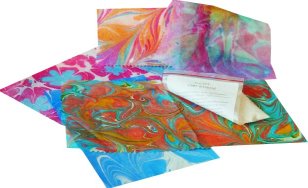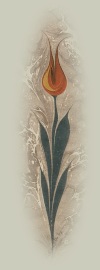
_____Ebru (Paper Marbling)
Although the origins of marbling are unclear, it seems to have evolved in the Moslem world in the sixteenth century, especially in India , Persia , and the Ottoman Empire . The art of ebrû has been practiced by Turks in an unbroken chain for almost five hundred years.
Some people claim that the literal meaning of "ebru" comes from "ab-i ru" , which means "face water", while others claim that it comes from the Persian word "ebri", which means "cloud-like" since they look like clouds in the sky.
Marbling is a technique that allows an artist to create elaborate swirling and intertwined strata of color and intricate design using liquid paints that have been suspended on a viscose medium. Once the artist manipulates the floating colors by means of special combs and other tools to create the desired effects, a sheet of alumed paper is carefully laid onto the liquid surface. Once the designs are transferred onto the paper, it can then be washed, dried, and pressed for further applications of marbling.
The traditional method, the one used in Turkish marbling, is to take a tray of viscous liquid called the size , sprinkle pigments mixed with a surfactant such as ox gall on to the size, one color after another until there is a dense pattern in many colors. Each successive layer of pigment spreads slightly less than the last and may need more surfactant to stay on top of the size. Once the colors are laid down, a stick or tools including rakes or combs may be drawn through the base pattern to make a new, more detailed pattern. Paper or cloth that has been coated with alum and allowed to dry is placed on the surface gently, which instantly absorbs the pattern. The excess pigment and size are rinsed off the paper and it is allowed to dry. Without the alum on the paper, the pattern would wash away with the excess. After the print is made, the remaining pigments are skimmed off the size to make it ready for a new pattern.
Traditional marbling uses carrageenan mixed with water for the size, real broomstraw to sprinkle the paint, ox gall for the surfactant, and water- base paint or gouache for the pigment. Modern marblers use a variety of new materials, often in combination with traditional materials. Other types of size have been used such as methylcellulose , gum tragacanth, gum agar, sodium alginate, or even wallpaper paste or laundry starch. Acrylic paints, watercolors, or ink can replace the traditional oil paints. Plastic broom straws can be used as well as bamboo sticks and eyedroppers to place the pigment on the surface of the size. Ox gall is still a superior surfactant, but other commercially available products may be used.
Marbling School
Flower Ebru
Ebru combined with Miniature
Ebru combined with Calligraphy

